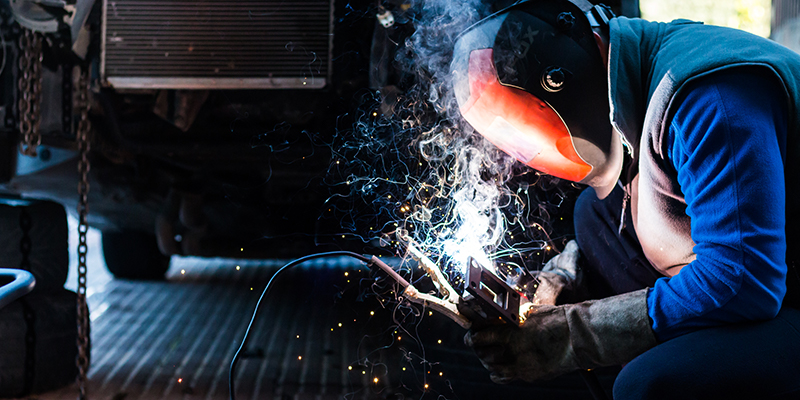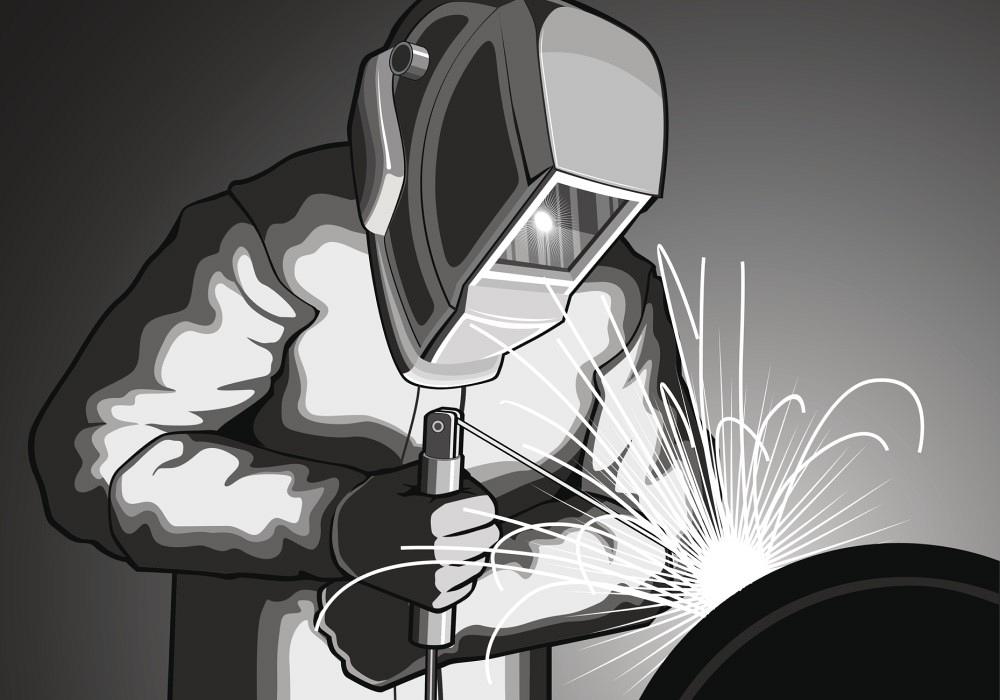Everything about Welding: Key Insights Into Techniques and Finest Practices for Success
Welding incorporates a range of strategies, each fit for specific materials and applications. Recognizing these methods, such as GMAW, SMAW, and TIG, is crucial for accomplishing ideal results. Moreover, the right tools and safety practices can not be neglected. As preparation and repairing play vital functions in the welding process, mastering these elements can greatly improve the quality of the last product. What are the essential variables that ensure a successful weld?
Understanding Different Welding Techniques
Welding techniques incorporate a selection of methods, each suited to particular applications and products. Amongst one of the most usual techniques are Gas Steel Arc Welding (GMAW), Secured Steel Arc Welding (SMAW), and Tungsten Inert Gas Welding (TIG) GMAW, also called MIG welding, is prominent for its speed and versatility, making it ideal for slim products. SMAW, or stick welding, is favored for its simpleness and performance in exterior environments, specifically with thicker metals. TIG welding uses precision and control, making it appropriate for detailed job and non-ferrous metals (Montana Mobile Welding and Repair Belgrade). Each method has its special benefits and factors to consider, enabling welders to choose the finest approach based on the job's demands, material type, and preferred outcomes. Understanding these techniques is necessary for successful welding
Important Welding Devices and Tools
While numerous welding methods call for certain abilities, the appropriate tools and devices are just as essential for accomplishing top quality results. Essential welding equipment includes welding equipments, which vary depending on the strategy-- such as MIG, TIG, or stick welding. Protective equipment, including headgears, handwear covers, and aprons, assurances safety and security and comfort throughout the procedure. Additionally, components and clamps help protect products in position, making certain accuracy in welds. Consumables like welding rods, cable, and shielding gas are additionally critical components that influence the quality of the weld. In addition, devices such as cutters and mills facilitate surface area preparation and post-weld finishing, adding to a specialist result. Purchasing premium devices inevitably improves the effectiveness and performance of welding projects.
Security Practices in Welding
Appropriate security methods are crucial in the welding industry to shield employees from possible risks. Welders must put on appropriate individual protective equipment (PPE), consisting of headgears with correct shading, handwear covers, and flame-resistant apparel. Sufficient ventilation is vital to decrease direct exposure to harmful fumes and gases generated throughout the welding procedure. In addition, workers need to be learnt the correct handling of welding tools to stop crashes. Fire precaution, such as keeping flammable materials far from the welding location and having fire extinguishers conveniently offered, are essential. Regular evaluations of devices and workspaces can aid identify prospective dangers prior to they bring about accidents. By sticking to these security methods, welders can develop a much safer working environment and lessen risks connected with their profession.
Readying Materials for Welding
Preparing products for welding is an essential step that considerably affects the high quality and stability of the final item (Montana Mobile Welding and Repair Belgrade Welding). Appropriate preparation entails cleaning the surfaces to remove pollutants such as corrosion, dirt, and oil, which can compromise the weld. Techniques such as grinding, fining sand, or making use of solvents are typically employed to accomplish a tidy surface. Furthermore, argon welding guaranteeing that the products fit with each other snugly is essential; voids can result in weak welds. It's likewise important to take into consideration the positioning and positioning of the parts, as this will influence the ease of welding and the final outcome. Ultimately, selecting the appropriate filler product and guaranteeing compatibility with the base metals is crucial for accomplishing solid, sturdy welds
Tips for Achieving High-Quality Welds
Achieving high-quality welds requires interest to detail and adherence to ideal practices throughout the welding process. Proper joint prep work is vital, making sure surfaces are cost-free and clean from pollutants. Selecting the ideal filler product and welding strategy based on the base steels is critical for excellent bonding. Preserving constant traveling speed and angle while welding can protect against issues and advertise harmony. Additionally, managing warm input is crucial; too much warmth can bring about bending and damaged joints. Consistently examining the welds throughout the procedure enables for prompt modifications if essential. Using suitable post-weld treatments, such as cleaning and stress relief, can enhance the sturdiness and stability of the weld, inevitably ensuring a successful outcome.
Troubleshooting Common Welding Issues
Welding often offers challenges that can impact the top quality and honesty of the final product. Typical problems such as porosity, inconsistent weld grains, and getting too hot can develop, each requiring particular repairing strategies. Understanding these troubles is important for welders to boost their skills and accomplish excellent outcomes.
Porosity Issues Explained
Porosity can usually be ignored, it stays an essential problem in welding that can endanger the integrity of a completed item. Porosity refers to the visibility of little gas pockets within the weld bead, which can lead and compromise the joint to premature failure. This problem typically develops from contaminants, moisture, or improper securing gas protection throughout the welding process. To minimize porosity, welders should verify that the base products are completely dry and tidy, use ideal protecting gases, and preserve constant welding parameters. Routinely checking the tools and atmosphere can likewise assist identify possible problems before they manifest in the weld. Resolving porosity effectively is essential for achieving solid, resilient welds that fulfill high quality criteria.

Inconsistent Weld Beads
Inconsistent weld beads can substantially impact the quality and stamina of an ended up item. Various variables add to this issue, consisting of improper traveling speed, incorrect amperage setups, and irregular electrode angles. When the welder relocates too quickly, a bead might show up narrow and lack penetration, while moving too gradually can create too much build-up. Additionally, using the incorrect amperage can lead to either undercutting or too much spatter, both of which concession weld integrity. The welder's technique, such as irregular lantern motion, can additionally cause unequal bead appearance. To mitigate these problems, welders ought to concentrate on maintaining stable, controlled movements and ensuring appropriate devices settings to attain uniformity in their welds. Consistency is vital to attaining trustworthy and strong welds.
Getting Too Hot and Bending Issues
Excessive warm during the welding process can bring about significant overheating and contorting concerns, influencing the structural stability of the work surface. These problems commonly show up as distortion, which can compromise placement and fit-up, making further assembly testing. Elements adding to overheating consist of the option of welding specifications, such as voltage and take a trip speed, as her comment is here well as the sort of product being bonded. To reduce these problems, welders should maintain constant traveling speed and proper heat input while checking the work surface temperature level. In addition, preheating or post-weld warmth therapy can assist reduce tensions triggered by rapid cooling - Montana Mobile Welding and Repair Fabrication. Regular evaluation and adherence to best methods are necessary in preventing overheating and guaranteeing the long life and reliability of welded structures
Regularly Asked Questions
What Are the Profession Opportunities in the Welding Industry?
The welding sector offers varied job possibilities, including settings as welders, teachers, designers, and inspectors. Specialists can work in manufacturing, construction, aerospace, and automobile sectors, profiting from solid need and competitive salaries in different duties.
Just How Can I Improve My Welding Rate Without Sacrificing Top Quality?
To improve welding rate without compromising quality, one must practice efficient techniques, keep devices, optimize settings, and enhance hand-eye sychronisation. Routine training and seeking feedback can also substantially contribute to attaining much faster, high-quality welds.
What Qualifications Are Readily Available for Welders?
Numerous qualifications exist for welders, consisting of those from the American Welding Culture (AWS), the National Facility for Construction Education and Study (NCCER), and numerous industry-specific organizations. These qualifications improve employability and show ability proficiency.
How Does Welding Impact the Features of Metals?
Welding influences the residential properties of steels by changing their microstructure, which can cause changes in ductility, stamina, and hardness. Warmth input and air conditioning rates during the process significantly affect these product qualities.
Can I Bonded Dissimilar Metals Together?
